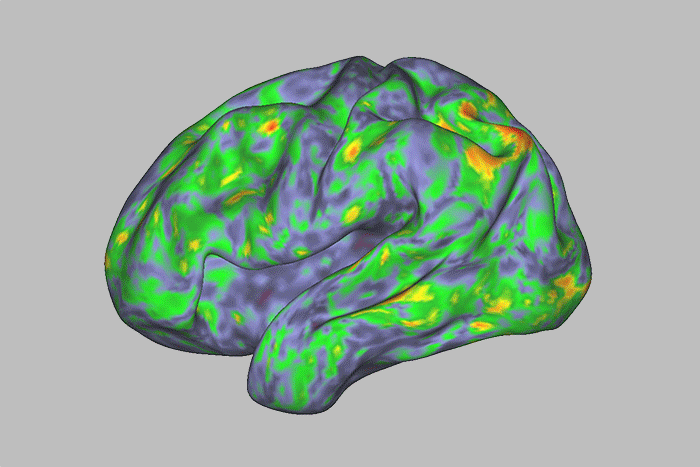
A study finds that psilocybin can desynchronize networks in the brain, potentially enhancing its plasticity.
Sara Moser/Washington University School of Medicine in St. Louis
hide caption
toggle caption
Sara Moser/Washington University School of Medicine in St. Louis
In the name of science, Dr. Nico Dosenbach had scanned his own brain dozens of times. But this was the first time he’d taken a mind-bending substance before sliding into the MRI tunnel.
“I was, like, drifting deeper into weirdness,” he recalls. “I didn’t know where I was at all. Time stopped, and I was everyone.”
Dosenbach, an associate professor of neurology at Washington University School of Medicine in St. Louis, had been given a high dose of psilocybin, the active substance in magic mushrooms, by his colleagues.
It was all part of a study of seven people designed to show how psilocybin produces its mind-altering effects.
The results, which appear in the journal Nature, suggest that psychedelic drugs work by disrupting certain brain networks, especially one that helps people form a sense of space, time and self.
“For the first time, with a really high degree of detail, we’re understanding which networks are changing, how intensely they’re changing and what persists after the experience,” says Dr. Petros Petridis of New York University’s Langone Center for Psychedelic Medicine, who wrote an editorial accompanying the study.
The research also provided a close look at how these drugs temporarily enhance the brain’s ability to adapt and change, an ability known as plasticity.
The disruptions in brain networks appear to be “where the plasticity effects of psychedelics are coming from,” says Dr. Joshua Siegel, a researcher at Washington University and the study’s lead author.
If that’s true, he says, it could explain why psychedelics appear to help people with addiction or depression.
A brainy trip
Dosenbach and other participants were randomly assigned to receive either a stimulant or 25 milligrams of psilocybin, a dose high enough to cause hallucinations.
“It was definitely an awesome experience for a neuroscientist,” he says.
“It’s really fascinating how your brain can fall apart — because how something breaks tells you how something works.”
Dosenbach’s trip took him places only a neuroscientist is likely to go.
“I was inside the brain, and I was riding brain waves, and I was Marc Raichle,” he says, referring to Dr. Marcus Raichle, a colleague and co-author of the study, who also happens to be a towering figure in the world of neuroscience.
As part of the study, participants’ brains were scanned an average of 18 times over a three-week period. Four repeated the experiment six to 12 months later.
“You’re bringing in single individuals many times,” Siegel says, “and that allows you to get a very detailed and precise map of their brain networks.”
The scans showed that psilocybin caused swift and dramatic changes to certain brain networks. Usually the neurons in a given network become active at the same time — often in tandem with other networks too.
“What’s going on during psilocybin is that populations of neurons that are normally in synchrony are out of synchrony,” Siegel says.
The brain “falls apart.” And it appears to respond by entering a state of enhanced plasticity that can last for weeks.
“Desynchronization probably is a critical clue as to where the plasticity effects of psychedelics are coming from,” Siegel says.
The loss of synchrony was greatest in a brainwide group of neurons called the default mode network, which is active when the brain is daydreaming or otherwise not focused on the outside world.
This network was discovered by scientists including Raichle, the man who became Dosenbach’s alter ego in the scanner.
The default mode network is critical to self-referential memory, which helps the brain keep track of information like, Who am I? And what was I doing? Siegel says.
Changing your mind
The study hints at how psychedelic drugs could be incorporated into the treatment of people with addiction, depression or post-traumatic stress.
“There seems to be this time of increased change that could be taken advantage of by therapists,” Petridis says.
A patient with addiction, for example, might be able to reframe their relationship with substances in the days and weeks following a dose of psilocybin, he says.
But the approach has risks, says Dr. Ginger Nicol, a psychiatrist at Washington University whose husband was in the study and took psilocybin twice.
“He had an almost religious experience the first time,” she says. “The second time, he saw demons.”
Even so, psychedelics may offer a way to help psychiatric patients recognize their own capacity to change, Nicol says.
“It takes years to figure that out in therapy,” she says. “This gives us a different way of thinking about learning and recovery.”
#brain #drugs #psilocybin #trigger #plasticity #Shots,
#brain #drugs #psilocybin #trigger #plasticity #Shots


